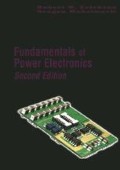Abstract
In the design methods of the previous chapter, copper loss P cu and maximum flux density B max are specified, while core loss P fe is not specifically addressed. This approach is appropriate for a number of applications, such as the filter inductor in which the dominant design constraints are copper loss and saturation flux density. However, in a substantial class of applications, the operating flux density is limited by core loss rather than saturation. For example, in a conventional high-frequency transformer, it is usually necessary to limit the core loss by operating at a reduced value of the peak ac flux density ΔB.
Access this chapter
Tax calculation will be finalised at checkout
Purchases are for personal use only
Preview
Unable to display preview. Download preview PDF.
References
W. J. Gu and R. Liu, “A Study of Volume and Weight vs. Frequency for High-Frequency Transformers,” IEEE Power Electronics Specialists Conference, 1993 Record, pp. 1123–1129.
K. D. T. Ngo, R. P. Alley, A. J. Yerman, R. J. Charles, and M. H. Kuo, “Evaluation of Trade-Offs in Transformer Design for Very-Low-Voltage Power Supply with Very High Efficiency and Power Density,” IEEE Applied Power Electronics Conference, 1990 Record, pp. 344–353.
A. F. Goldberg and M. F. Schlecht, “The Relationship Between Size and Power Dissipation in a 1–10MHz Transformer,” IEEE Power Electronics Specialists Conference, 1989 Record, pp. 625–634.
K. D. T. Ngo and R. S. Lai, “Effect of Height on Power Density in High-Frequency Transformers,” IEEE Power Electronics Specialists Conference, 1991 Record, pp. 667–672.
R. B. Ridley and F. C. Lee, “Practical Nonlinear Design Optimization Tool for Power Converter Components,” IEEE Power Electronics Specialists Conference, 1987 Record, pp. 314–323.
R. C. Wong, H. A. Owen, and T. G. Wilson, “Parametric Study of Minimum Converter Loss in an Energy-Storage Dc-to-Dc Converter,” IEEE Power Electronics Specialists Conference, 1982 Record, pp. 411–425.
Author information
Authors and Affiliations
Rights and permissions
Copyright information
© 2001 Springer Science+Business Media, LLC
About this chapter
Cite this chapter
Erickson, R.W., Maksimović, D. (2001). Transformer Design. In: Fundamentals of Power Electronics. Springer, Boston, MA. https://doi.org/10.1007/0-306-48048-4_15
Download citation
DOI: https://doi.org/10.1007/0-306-48048-4_15
Publisher Name: Springer, Boston, MA
Print ISBN: 978-1-4757-0559-1
Online ISBN: 978-0-306-48048-5
eBook Packages: Springer Book Archive

